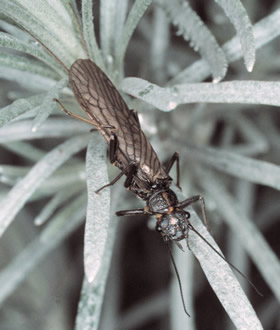| The Riverfly Recording Schemes
- for Caddisflies, Mayflies and Stoneflies (Previously known as CAMSTARS) |
Plecoptera Recording Scheme (Stoneflies or Needleflies)
Background The Plecoptera Recording Scheme was established in 2003 in collaboration with the Biological Records Centre. The four main aims of the scheme are to: • encourage interest in, and the recording of, the
34 British species; The scheme holds approximately 90,000 records, which are being collated and validated. Records and distribution maps will be facilitated through the National Biodiversity Network Gateway Project.
Current targeted research on PlecopteraFacilitating interest in the group. Action:A ‘Guide to the British Stonefly (Plecoptera) families: adults and larvae’, by David Pryce et al, is available from the Field Studies Council. The Riverfly Partnership initiative, ‘River invertebrate monitoring for anglers’, enables registered groups to monitor the water quality of their local rivers. Plecoptera is recorded as a key group in the monitoring. Isogenus nubecula: This species is apparently confined to the Welsh River Dee between Newbridge and Farndon. It has suffered a catastrophic decline over the last 20 years. A survey of this area in 2004 failed to locate the species. Action: Proposed as a candidate Biodiversity Action Plan species; further survey work is urgently required. Malaise trapping: Malaise traps have been run at six sites during the past two years in order to obtain data on flight periods and quantitative information on the composition of Plecoptera communities. Action: Analyse and publish the data, and carry out further recording. Leuctra species: What determines the distribution of the six British species of Leuctra? Up to five species can be found at some sites, yet other sites host only a couple of species. Action: To gather and interrogate information on this genus and further understand the distributions. Rhabdiopteryx acuminata: Found at scattered sites in central
Wales and northern England, the habitat preferences of
this species are not clear. Action: Attempt to define habitat
requirements more precisely in order to carry out targeted
survey work.
|

